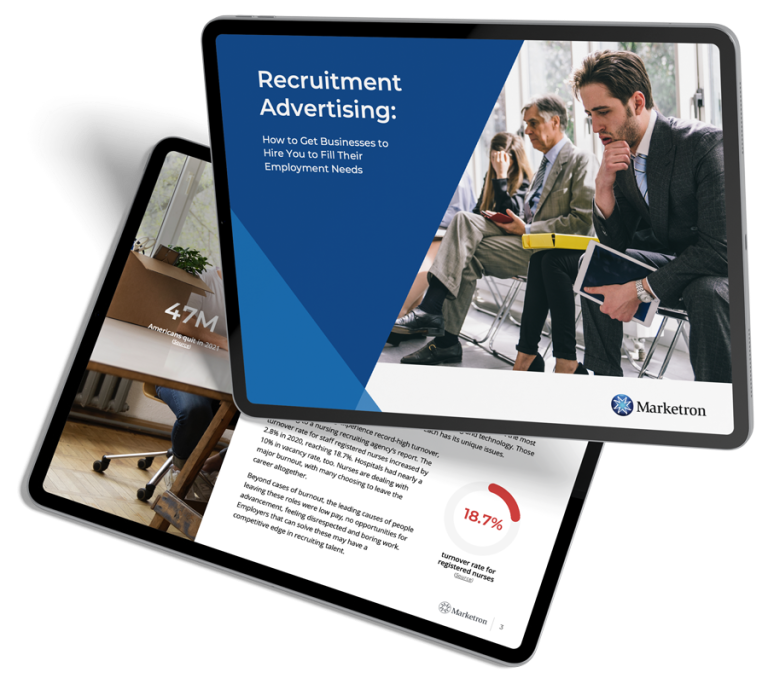Recruitment advertising is a hot topic for broadcast and media sellers. It’s an opportunity to expand revenue with advertisers and win new business. We recently hosted a webinar on the subject, Hiring Minds Want to Know, featuring experts. We received many questions during the Q&A portion and wanted to share them with our audience.
When should you use geofencing vs. targeted display ads?
The quick answer is that you can use both in an integrated campaign. If you’re looking at one or the other, the difference is where vs. who. If you are trying to attract applicants in a specific area — competitor places of business, locations where a specific type of worker would be — geofencing is a strong strategy. Targeted display is useful when advertisers know what kind of employee they want to hire.
Are there resources that demonstrate what companies are losing by not filling positions?
There is substantial data collection and analysis on the topic. It’s a moving target because it depends on the industry, job type, economic environment, business, etc. A company’s losses can fall into several categories: direct costs, lost revenue, marketing, recruiting, opportunity costs and soft costs. A LinkedIn Pulse article offers come calculation formulas. Another from Built In is also a good reference.
What channels have the best interaction rate for recruitment?
Any channel can deliver strong results if the message, targeting and experience align with what an employer needs and what a job seeker wants. In the webinar, Erica Dreyer spoke about campaigns that leveraged geofencing, SEM (search engine marketing) and OTT/CTV. This integrated approach works well for an organization looking to hire drivers and increase enrollees for their driving school.
For average click-through rates (CTRs) for SEM and display by industry, this resource from WordStream is helpful and regularly updated.
How do you track ROI with recruitment campaigns?
Effective ROI tracking starts with being a partner to your client. You won’t be able to optimize ads unless you know what’s working. The challenge primarily rests in the latency between the first exposure to an ad and the eventual conversion (job application submission).
We’ve tracked that span with our media customers, and it can be as long as 60 days. Additionally, you need to know if those conversions become hires.
Much like retail advertising, your responsibilities end when the customer walks through the door. You’ve provided them the “lead,” and they must now deliver a positive candidate experience.
Other factors in ROI involve the national average for hiring costs for a position. It needs to include more than recruiting costs; there are also onboarding and training expenses.
When prospecting, is there a “magic number” on when to contact organizations regarding recruitment advertising?
If you tally quantities of job postings to qualify a prospect, you risk disqualifying what could otherwise be an optimal customer. It’s common for companies to need multiple hires to occur off one job posting. In fact, we’ve seen postings that require dozens of hires. During a CNA (customer needs assessment), this should be one of the first questions you ask: “I saw you have X job postings. How many hires will you seek for each?”
The answer should guide your subsequent actions, including the duration of the campaign and its overall cost.
What if culture is the reason for high turnover, and all we’re doing is moving the turnover line?
This is another question to address in the CNA. You can also research the prospect on employee review sites like Glassdoor. You can learn a lot from these, particularly regarding poor onboarding and frequent staff turnover. Pay attention to the rebuttals posted by the employer.
While some former employees will post negative reviews that may be unwarranted, if the employer hasn’t responded to any of these, it could be a red flag on culture. As a result, you may be better off moving on to another business.
With omnichannel recruitment campaigns, what’s the average budget to recommend?
It depends. The factors that influence budget include:
- How in demand the job is and the competition
- The seniority and salary for the position (The higher these are, the more budget they’ll need.)
- The size of the company and its revenue
- How long it typically takes to fill a role (Those with more specific skills or expertise usually take longer.)
- Historical data on previous spend (if available)
You want to be conscious of how cost-sensitive the employer is, but recruitment advertising often takes time (recall the 60-day span above). It’s not as “fast” as promotional advertising. You can always present clients with two or three budget scenarios based on a mix of tactics.
What messaging works in recruiting millennials and Gen Z?
Millennials and Gen Z have different expectations around employment than previous generations. Those ideas shifted more during the pandemic. Both groups are mostly digital natives, so technology has been a constant in their life, and they want an easy, intuitive user experience when applying for jobs.
Both groups care a lot about a company’s culture and values, especially around environmental and social issues. In fact, 75% of millennials said they wanted their personal values to align with their employers’. Other key themes in recruiting millennials include:
- Supporting diversity
- Being transparent about salary and benefits
- Highlighting employee advocacy programs
- Demonstrating the company’s trustworthiness and credibility (If this generation trusts an organization, they are 22 times more likely to want to work there.)
- Offering flexibility and remote work
- Emphasizing learning, development and career growth
Gen Z has many of these same expectations about work. New research points out their priorities:
- Fair pay
- Diverse teams
- Meaningful work
- Focus on mental health
- A positive onboarding process
Another study found that 76% of Gen Zers see a great place to work as one that’s “caring, friendly and socially conscious.”
In developing messaging and what channels to use, take these data points and determine how they fit the specific job and industry.
What tactics would you use with companies seeking to recruit employees with specific skills?
Any tactic with targeting for demographics and behaviors/interests works well — display (static and video), OTT/CTV and social media enable this. SEM could also work by bidding on skill sets or profession keywords. The more defined a company’s ideal candidate is, the more powerful targeting can be.
How do you avoid overlap and saturation with multiple companies looking to hire the same type of job seeker?
It can be challenging if your market is small, but it’s less so in larger cities or for companies recruiting for positions where the person can be anywhere. Even though employers are looking for the “same” type of worker, there will likely be some differentiators, so showcasing those in creative can be helpful. Also, your client’s budget will determine where they place ads and when. It can be a balancing act; however, think of all the advertisers you have in the same industry — retail, restaurants, etc. — and how you manage it in those instances. You can apply the same logic here.








